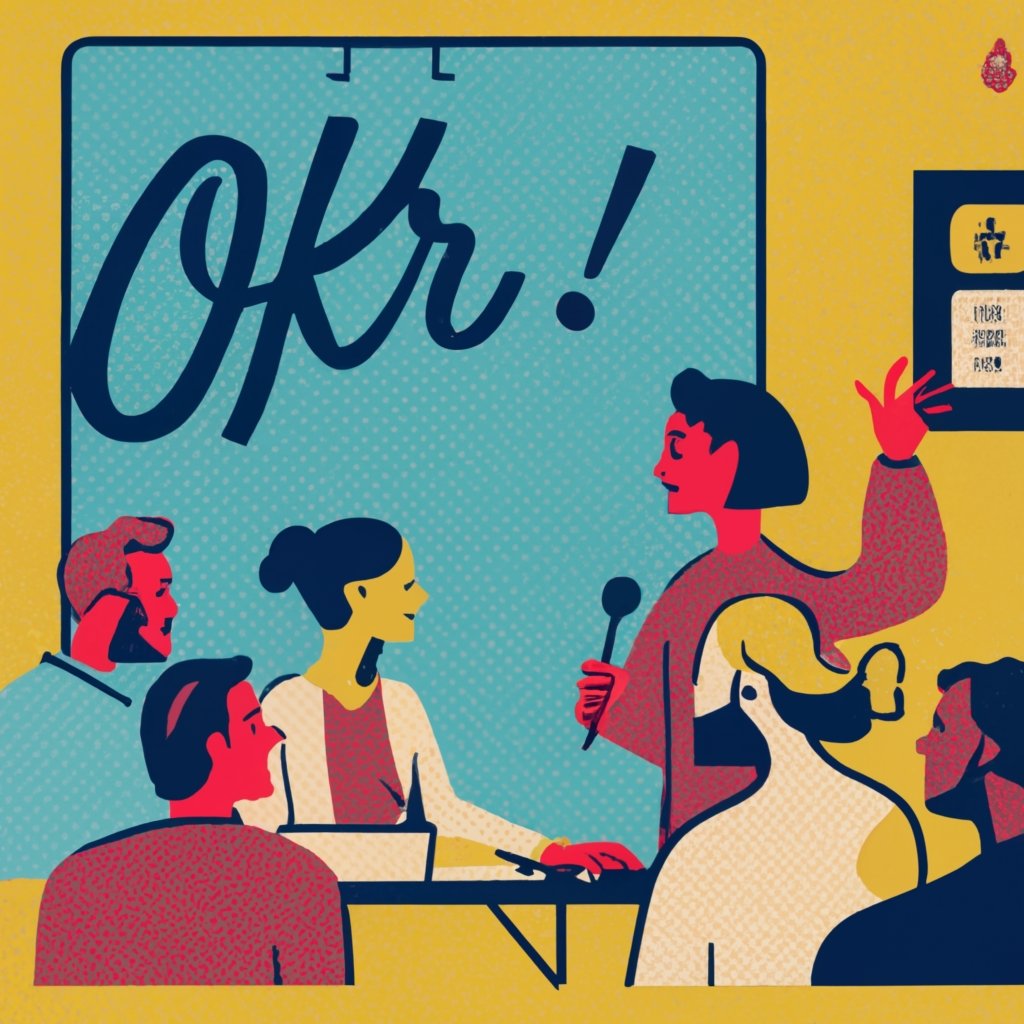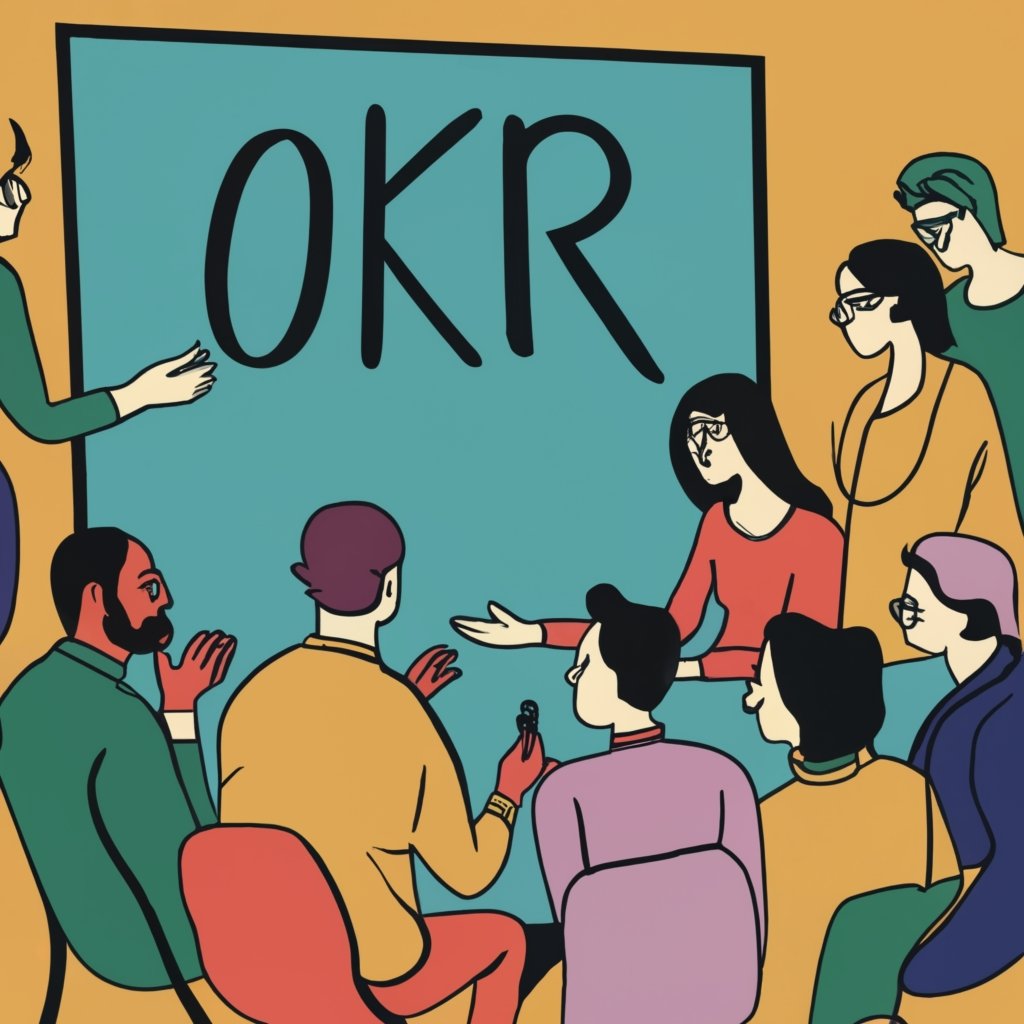Table of Contents

OKRs (Objectives and Key Results) are a goal-setting framework that helps organizations define measurable goals and track their outcomes, promoting alignment and engagement around measurable and ambitious goals. OKRs are used to track teams not individuals.
Originally developed by Intel, OKRs have gained widespread adoption in recent years due to their ability to align teams and individuals with company objectives. An OKR is a simple yet powerful tool that helps organizations set goals and track progress towards achieving them.
The basic idea behind OKRs is to set specific, measurable objectives that are aligned with the company’s overall mission and vision. These objectives should be challenging but achievable, and should be accompanied by key results that measure progress towards achieving them. By setting clear objectives and tracking progress towards them, businesses can ensure that everyone is working towards the same goals and that progress is being made in the right direction.
The significance of OKRs lies in their ability to align teams and individuals with company objectives. By setting clear goals and tracking progress towards them, businesses can ensure that everyone is working towards the same objectives. This not only increases productivity and efficiency, but also helps to create a sense of purpose and motivation among employees. With OKRs, businesses can set ambitious goals and track progress towards achieving them, ultimately leading to greater success and growth.
Understanding OKRs
OKRs, or Objectives and Key Results, are a popular goal-setting framework used by many companies to help align their teams and focus on outcomes. This framework was first introduced by Intel in the 1980s and has since been adopted by many other companies.
The OKR framework consists of two parts: objectives and key results. Objectives are the goals that a company or team wants to achieve, while key results are measurable outcomes that indicate progress towards those goals.
One of the key benefits of using OKRs is that they help companies and teams focus on outcomes rather than just activities. By setting clear objectives and measurable key results, teams can better understand what they need to achieve and how they will measure success.
A benefit of using OKRs is that they can help improve communication and alignment within a company. When everyone is working towards the same objectives and key results, it can help break down silos and promote collaboration across teams.
Overall, the OKR framework is a powerful tool that can help companies and teams focus on outcomes and improve communication and alignment. By setting clear objectives and measurable key results, companies can better understand what they need to achieve and how they will measure success.
Significance of OKRs in Business
OKRs (Objectives and Key Results) are a powerful tool for businesses to engage their team members and align them with the company’s mission and strategy. OKRs are a goal-setting framework that helps businesses set ambitious and measurable goals that are aligned with their mission and strategy.
One of the key benefits of OKRs is that they provide a clear and measurable metric for success. By setting specific and measurable objectives, businesses can track their progress and determine whether they are on track to achieve their goals. This helps businesses to stay focused and motivated, and to make adjustments to their strategy as needed.
OKRs Being Effective Tools
Another significant benefit of OKRs is that they promote engagement among team members. By involving team members in the goal-setting process, businesses can ensure that everyone is aligned with the company’s mission and strategy. This helps to create a sense of ownership and accountability among team members, which can lead to increased engagement and motivation.
OKRs are also an effective tool for measuring qualitative goals. By setting specific and measurable objectives, businesses can track progress towards achieving their goals and make adjustments as needed. This helps businesses to stay on track and ensure that they are making progress towards achieving their goals.
John Doerr, the inventor of OKRs, believes that OKRs are a powerful tool for businesses to drive alignment and engagement among team members. He emphasizes the importance of setting ambitious goals that are aligned with the company’s mission and strategy, and of providing support and resources to help team members achieve those goals.
In summary, OKRs are a powerful tool for businesses to engage their team members, align them with the company’s mission and strategy, and set ambitious and measurable goals. By using OKRs, businesses can stay focused and motivated, track their progress, and make adjustments to their strategy as needed.
Implementing OKRs

Implementing OKRs involves a collaborative process between managers and employees to set measurable goals that align with the company objectives. It is important to prioritize the most important goals and create a clear path to achieving them.
One key aspect of OKRs is the use of stretch goals, which are ambitious targets that push employees to innovate and think outside the box. These goals should be challenging but still achievable, and they should help drive the business strategy forward.
To ensure that OKRs are effective, it is important to have a clear methodology for goal-setting and tracking progress. This includes identifying key performance indicators (KPIs) and using them to measure progress towards the goals. It is also important to have a system in place for tracking the progress of individual tasks and projects.
Leaders play an important role in implementing OKRs by setting a top-level objective, or North Star, that guides the direction of the company. They also need to ensure that there is buy-in from all employees and that there is a culture of accountability and transparency.
OKRs can have many benefits for businesses, including increased employee engagement, improved performance management, and better alignment between individual and company goals. However, it is important to implement them effectively in order to see these benefits.
Companies like Google, Amazon, LinkedIn, and Uber have all successfully implemented OKRs, and there are many resources available, including OKR templates and goal-setting methodologies, to help businesses get started.
Case Studies of OKRs in Businesses

Many businesses have implemented OKRs to improve their performance and achieve their goals. Here are a few examples of how some of the world’s most successful companies have used OKRs:
Google is one of the most well-known companies that have implemented OKRs. The company uses OKRs to set goals for its employees and measure their progress. Google’s OKRs are divided into two categories: “Objectives” and “Key Results.” Objectives define company goals, while Key Results measure the progress toward them.
Google’s OKRs are designed to be ambitious and challenging, but also achievable. Google sets a broad goal, or Objective, to elevate the overall experience of its users on their platform. To gauge the effectiveness of their efforts, they establish a specific Key Result: they seek to achieve a measurable increase in their User Satisfaction Score. The target is a substantial 10% uptick, which quantifies their ambition to not just make incremental improvements but to significantly enhance how users feel about their interactions with Google’s services. This clear, numerical benchmark helps the company to track progress, make data-driven decisions, and focus on strategies that can contribute directly to this improvement.
Intel
Intel is another company that has successfully implemented OKRs. The company uses OKRs to align its employees’ goals with the company’s overall strategy. Intel’s OKRs are focused on driving innovation and improving performance.
For example, one of Intel’s Objectives might be to “Increase Market Share,” and one of the Key Results might be to “Launch Three New Products in the Next Quarter.”
Amazon
Amazon is known for its customer-centric approach, and the company has used OKRs to help achieve this goal. Amazon’s OKRs are focused on improving customer experience and driving growth.
For example, one of Amazon’s Objectives might be to “Improve Delivery Times,” and one of the Key Results might be to “Reduce Average Delivery Time by 20%.”
This Objective underscores Amazon’s push for speed and efficiency in logistics. The Key Result offers a quantifiable goal, ensuring progress is measurable. It’s a strategy designed not only to satisfy customers with faster service but also to reinforce Amazon’s competitive edge in the market.
By setting such OKRs, Amazon can direct its resources and innovate in its delivery systems. Each step towards this 20% reduction in delivery times is a step towards greater customer satisfaction and, ultimately, continued growth for the company.
LinkedIn’s approach to OKRs (Objectives and Key Results) has been instrumental in its mission to create economic opportunities for the global workforce. The platform’s OKR framework is tailored to set measurable objectives and key results, which are regularly reviewed to ensure alignment with the company’s long-term goals. The executive team, under the leadership of Jeff Weiner, encourages setting three to five challenging OKRs per quarter. These OKRs are a mix of stretch goals and achievable targets, aiming to inspire employees and drive significant growth.
Weiner’s broader definition of OKRs makes them more personal, focusing on accomplishments over a specific period that push the limits of the team’s capabilities. The process is supported by regular check-ins, with weekly and six-weekly meetings designed to keep track of everyone’s progress. This rigorous follow-up is a key component of LinkedIn’s management strategy, enabling the team to stay focused and maintain a trajectory toward their ambitious goal
For more detailed insights into LinkedIn’s use of OKRs and how they have driven growth and user engagement, you can explore the following resources:
Uber
Uber is a ride-sharing company that has used OKRs to improve its performance and drive growth. Uber’s OKRs are focused on improving customer experience and increasing the number of rides taken on the platform.
An objective for Uber’s might be to “Increase the Number of Rides”. A Key Results might be to “Increase the Number of Rides by 20% in the Next Quarter.”
Overall, OKRs have proven to be a valuable tool for businesses looking to improve their performance and achieve their goals. By setting ambitious yet achievable goals and measuring progress towards those goals, businesses can improve their performance and drive growth.
Big Take Away
In closing, OKRs have revolutionized the way organizations align and mobilize their efforts towards shared objectives. This framework has been pivotal in uniting teams under a common goal, creating a synergy that transforms ambitious targets into tangible results. Companies like LinkedIn have showcased the potential of OKRs in propelling growth and user engagement, demonstrating that when teams are not just working in the company but for the company, the bounds of achievement expand. Embracing OKRs is more than adopting a methodology; it’s about fostering a culture where every stride is measured, every effort is directed, and every milestone is a step closer to the ultimate vision of the company.
OKRs (Objectives and Key Results) are a goal-setting framework that helps organizations define measurable goals and track their outcomes, promoting alignment and engagement around measurable and ambitious goals.
Recent Posts
Understanding Time Feature ReleaseConcept of Time in Product RoadmapsImportance of Timing for Feature ReleasesPlanning the RoadmapSetting Strategic GoalsIdentifying Key MilestonesPrioritizing...
Portfolio Kanban: A Powerful Tool for Effective Portfolio Planning
Fundamentals of Portfolio KanbanDefining Portfolio KanbanKey Principles of Portfolio PlanningBenefits of Portfolio KanbanSetting Up a Portfolio Kanban SystemIdentifying Portfolio ItemsVisualizing the...

